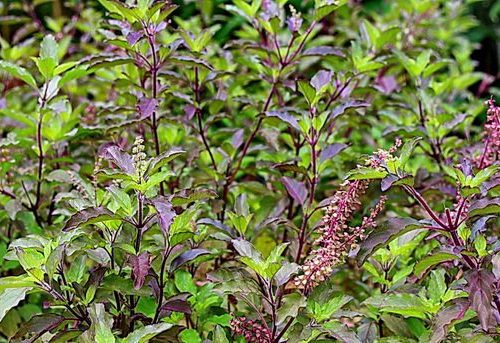
Ocimum tenuiflorum (synonym Ocimum sanctum), commonly known as holy basil or tulsi, is an aromatic perennial plant in the family Lamiaceae. It is native to the Indian subcontinent and widespread as a cultivated plant throughout the Southeast Asian tropics. Tulsi is cultivated for religious and traditional medicine purposes, and also for its essential oil. It is widely used as a herbal tea, commonly used in Ayurveda, and has a place within the Vaishnava tradition of Hinduism, in which devotees perform worship involving holy basil plants or leaves. Holy basil is an erect, many-branched subshrub, 30–60 cm (12–24 in) tall with hairy stems. Leaves are green or purple; they are simple, petioled, with an ovate, up to 5 cm (2.0 in)-long blade, which usually has a slightly toothed margin; they are strongly scented and have a decussate phyllotaxy. The purplish flowers are placed in close whorls on elongated racemes.
USES
Holy basil is a plant. It is originally from India
but now grows in Australia, West Africa, and
some Middle Eastern countries. It is used in
Ayurvedic medicine. The leaves, stems, and
seeds are used to make medicine.
Holy basil is used for anxiety, stress, diabetes,
high cholesterol, and many other conditions, but
there is no good scientific evidence to support
these uses.
In cooking, holy basil is used for its peppery taste, and is sometimes called "hot basil".
Climate:
Tulsi is a tropical plant, it requires warm temperatures to germinate and should be kept in a place that's at least 70 degrees. If your house is particularly cool, consider using a seedling heat mat to warm soil temperatures. The soil should be kept continuously moist, but not soggy.
Soil
The plant is sufficiently hardy and it can be grown on any type of soil except the ones with highly saline, alkaline or water logged conditions. However, sandy loam soil with good organic matter is considered ideal. The crop has a wide adaptability and can be grown successfully in tropical and sub-tropical climates.
The land is brought to fine tilth and laid out into plots of convenient sizes for irrigation. It is preferable to add 15 tonnes of farm yard manure per hectare during the preparation of land and mixed well in the soil
HARVESTING
The crop is harvested at full bloom stage. The first harvest is obtained at 90-95 days of planting. Then it may be harvested every 65-75 days interval. Harvesting is done usually on bright sunny days for good oil yield and its quality. It is not desirable to harvest the crop if there was a rain in the previous day
IRRIGATION:
Irrigation depends upon the moisture content of soil. In summer 3 irrigation per month are necessary, in rainy season no irrigation is required. About 12-15 irrigation are enough during the year.
Economics Of One Acre Black Tulsi Cultivation:
Expenditure
| Distance (in acre) | Sapling (in land) | Cost (per plant) | Total | Other expenses (as per require-ment) | Cost of cultivation |
|---|---|---|---|---|---|
| 1*5 ft | 5 Kg | 2000 rs. | 5kgx2000 = 10,000/- | Fertilizers Land preparation Labor expenses etc. | 10,000 /- |
| Total Cost Of Cultivation: 10,000/- | |||||
INCOME FOR FARMING OF BLACK TULSI LEAF 1 ACRE
| Production | Production/kg(Approximated) | Rate | Revenue | Remarks |
|---|---|---|---|---|
| Dry leaf | 500 | 80/- | 40,000/- | Production start in 3 months |
| Seedf | 500 | 100/- | 50,000/- | |
| Whole Panchang | 1000 | 10/- | 100,000/- |
Technical Support & Services:
We also provide technical support for farming. Our Service Department with technically qualified staff provide after sales service and farmers' advisory services to our customers to get better plant establishment and faster growth of Herbal and Horticultural plantations. We have largest network of employees who deliver Plants to customers at their door steps. Free technical services to customers on planting method, management practices and plant protection measures. Our teams of Agricultural Experts periodically visits and supervise the plantations and suggest necessary guidelines to get better growth and higher returns. The income & expenditure indicated by the company is an approximate figure, as it also depends on the nature and hard work of the farmer
SERVICES
- This includes Supervision, consultancy, guidance, Transportation cost first year on call.
- First production starts after 6th month.
- Buy back agreement of Black Tulsi.
- The income expenditure indicated by the company is an approximated figure, as it also depends on the nature and hard work of the FARMER.
- Black tulsi growing first harvesting practical training.
- Plantation cost is to be borne only once and then for next 6-month yield can beextracted
